《英语教学法教程》课件—04
英语教学法教程王蔷
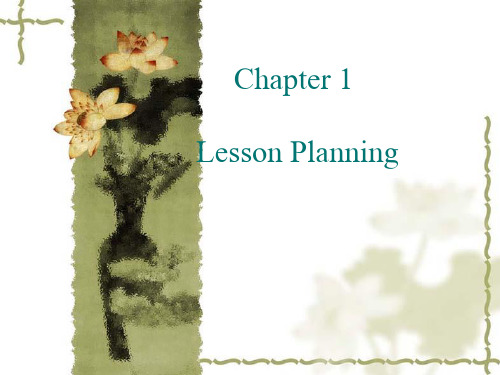
1) understanding the aims and language contents of the lesson;
2) distinguishing the various stages of a lesson;
Knowing about
the course the institution(school); the learners the syllabus
Micro planning is usually for a special lesson./ lesson
plan
Components of a lesson plan
Chapter 1 Lesson Planning
❖ Why is lesson planning necessary? ❖ Principles for good lesson planning ❖ Macro planning vs. micro planning ❖ Components of a lesson plan ❖ Sample lesson plans
Variety:
different types of activities and a wide selection of materials.
Flexibility: different methods and techniques
the contents and tasks should Learnability: be within the learning capability
7) After class reflection
《王蔷英语教法》PPT课件.ppt

(3)导学课
• 共四次导学课 • 语音教学系统地址: http://218.19.140.194/main/index.jhtml • 可以通过网院主页 /index.html 左下方的“华师在线语音教学系统”进 入。
(4) BBS ( “交流园地”或“课程交流” )
内容
2、本课程的学习内容
Language and (language) Learning
Communicative Principles and Activities(and Task-Based Language Teaching) The National English Curriculum Lesson Planning Classroom Management Teaching Pronunciation Teaching Grammar Teaching Vocabulary
网络课件中的内容
• 课件中的主要内容:
– 精讲课:视频录像 + PPT – 期末考试模拟试题(附答案)两套 – 课外阅读材料(参考资料)。
关于网络课件中“课外阅读”的 材料
• 网络课件中“课外阅读”的材料内容不 会作为考试题目的知识点,但: • 建议同学们,尤其是已经在当英语教师 的同学们,要在适当的时候阅读,这对 英语教学实践和教研将有裨益。
The structural view
Sentences phrases Words Morphemes (the smallest meaningful unit) Phonemes (the smallest unit)
Top
The structural view
Syntactic system (phrases & sentences) …
英语教学法Unit4
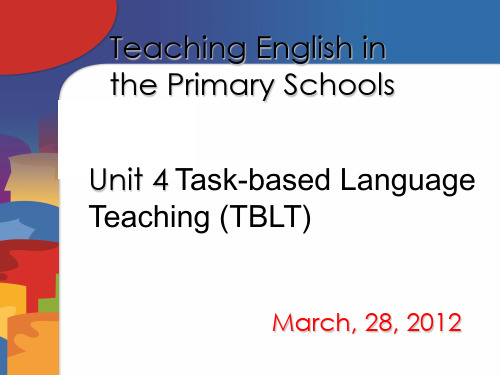
An exercise
Going shopping Look at Mary’s shopping list. Then look at the list of items in Abdullah’s store.
Mary’s shopping list 1. oranges 2. eggs 3. flour 4. powdered milk 5. biscuits 6. jam Abdullah’s store 1. bread 2. salt 3. apples 4. Coca Cola 5. tins of fish 6. four 7. chocolate 8. sugar 9. curry powder 10. biscuits 11. powdered milk 12. dried beans
——Skehan(1998) ( )
PURPOSE
CONTEXT PROCESS
OUTCOME
TASK
MEANING
AUTHENICITY
COMMUNICATIVE
Difference between exercises, exercise-tasks, and tasks
Exercises, exercise-tasks, and tasks
—Rod Ellis
1. Meaning is primary. (意义是首要的)。 意义是首要的) 2.There is a communicative problem to be solved. (有某 个交际问题需要解决。 个交际问题需要解决。) 3.There is some sort of relationship to comparable realworld activities.(任务具有在现实生活中有发生的可能 ( 性。) 4.Task completion has some priority.(完成任务是首要 ( 考虑。) 考虑。 5.The assessment of the task is in terms of outcomes. 根据任务的结果评估任务的执行情况。 (根据任务的结果评估任务的执行情况。)
王蔷教学法讲义
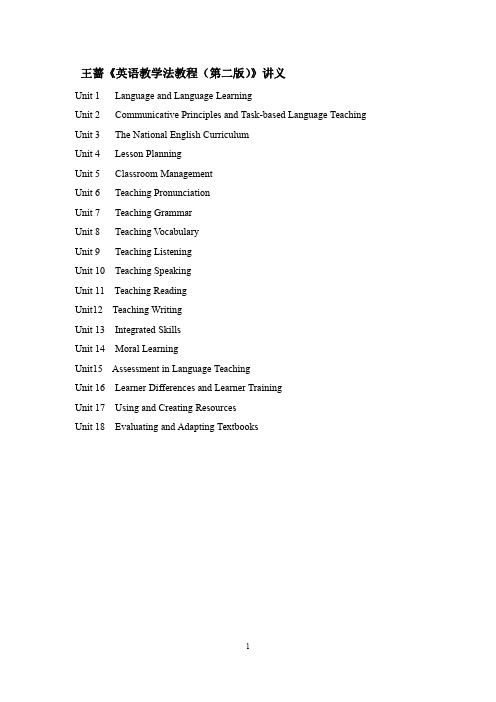
王蔷《英语教学法教程(第二版)》讲义Unit1Language and Language LearningUnit2Communicative Principles and Task-based Language Teaching Unit3The National English CurriculumUnit4Lesson PlanningUnit5Classroom ManagementUnit6Teaching PronunciationUnit7Teaching GrammarUnit8Teaching VocabularyUnit9Teaching ListeningUnit10Teaching SpeakingUnit11Teaching ReadingUnit12Teaching WritingUnit13Integrated SkillsUnit14Moral LearningUnit15Assessment in Language TeachingUnit16Learner Differences and Learner TrainingUnit17Using and Creating ResourcesUnit18Evaluating and Adapting Textbooks语言和语言学习【考情分析】本章主要讨论语言观和语言学习观、优秀教师的基本素养以及如何成为一名优秀的英语教师。
主要考点:结构主义、功能主义和交互语言理论;行为主义、认知主义、建构主义和社会建构主义学习理论;一个好的语言老师必备的素养;教师专业技能发展等。
【知识框架】Unit1 Language and Language Learning Views on languageViews in generalA good language teacherFunctional viewBehaviourist theoryCognitive theoryConstructivist theorySocio-constructivist theoryInteractional viewHow can one becomea good language teacher?An overview of the bookethic devotionprofessional qualitiespersonal stylesStage1Language trainingStage2Learning,practiceand reflectionGoal语言和语言学习1.1How do we learn languages?We learn language at different agesPeople have different experiencesPeople learn languages for different reasonsPeople learn languages in different waysPeople have different understandingsPeople have different capabilities in language learningLearning can be affected by the way how language is taughtLearning is affected by the degree of success one is expect to achieve.Thus the challenge confronting language teaching is how teaching methodology can ensure successful learning by all the learners who have more differences than the commonality.1.2Views on languageIn the past century,language teaching and learning practice has been influenced by three different views of language,namely,the structural view,the functional view and the interactional view.(1)The structural view of language结构主义语言观The structural view of language sees language as a linguistic system made up of various subsystem(Larsen-Freeman&Long,1991):the sound system(phonology音系学);the discrete units of meanings produced by sound combinations(morphology形态学/词汇学),and the system of combining units of meaning for communication (syntax句法学).Each language has a finite number of such structural items.结构主义语言观:结构主义语言观将语言看作由许多子系统组成的语言学系统(Larsen-Freeman&Long,1991):语音系统(音系学);产生于语音集合的意义的离散单位(形态学),以及交际意义的集合单元系统(句法学)。
(完整版)《英语教学法》Unit_4_Lesson_Planning
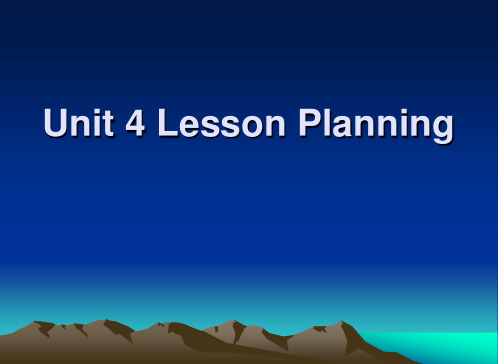
• Language teachers benefit from lesson planning in :
lesson planning?p.52-53 • What types of lessons do you know?
• Lesson planning means making decisions in advance about what techniques, activities and materials will be used in the class.
• ● Size of classroom: restricts some types of
activities
• ● Teaching aids: sufficient or not • ● Time of day: influences the types of
activities used (p.m. or a.m.)
• Procedures are the detailed steps in each teaching stage.
What teaching model is the easiest procedure to teach a new
structure-based lesson?
• PPP model, which includes presentation, practice and production.
英语教学法(教学PPT)

• S1:Which do you prefer ,tea or coffee ?
• S2:I prefer coffee./I prefer tea./I like them all./I don't like either .
• The activity is not merely reacting to the questions .But it is not a really task .It depends on the teacher's choices.
• Input:Questionnaire on sleeping habits • Activity:1)Reading questionnaire 2)Asking
and answering questions about sleeping habits • Teacher role:monitor and facilitator;to specify what is regarded as successful completion of the task • Learner role :conversational partner
15
An example in TBLT
• 语言结构:This is ... • 语言功能:指定与介绍(indentification
and introduction) • 1.学生模拟产品讲解员(或商店售货员)向
顾客介绍产品(或商品)简单描述用途:
• This is a thermometer.It is used to measure temperetures.
• 适用于我国英语教学现状的“任务型”教学法
任务是可称之为“中间型”教学任务
英语教学法教程 课件
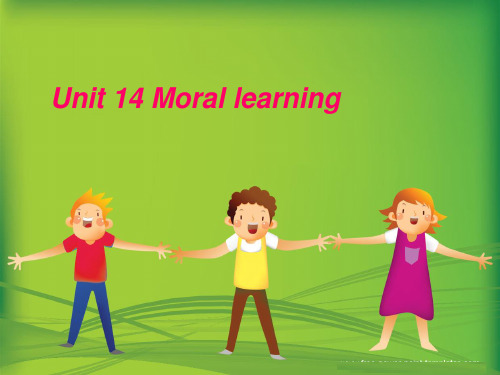
There is a Chinese saying that'Teachers are engineers of the soul'. This suggests that we are not just responsible for students' moral development. The word 'education' comes from the Latin verb educare, which means to'bring out'. In other words, teachers should try to bring out the full potential of their students as human beings, so they can live meaningful, fulfilling and responsible lives. At first glance, English language teaching may not seem an important area for moral learning. It is a foreign language and is sometimes associated with social values that are not shared by Chinese people. On the other hand, English lessons can provide excellent opportunities for a focus on moral values
Didactic model: students are explicitly and regelarly taught moral behaviour, as determined by the teacher.
《小学英语教学法》课件

Collect feedback from students on their learning experience, including the effectiveness of the course in enhancing their English skills and knowledge
Encouraging active learning
promoting student participation in class ions, role playing, and other interactive activities
Assessing student progress
Evaluate one's own delivery of instructions, including language clarity, ability to engage students, and utilization of effective teaching techniques
Detailed description
Summary
Learning language by completing practical tasks, emphasizing the practical application of language and problem-solving abilities.
Summary
Teaching language by simulating real-life scenarios to help students understand and apply language.
Detailed description
《英语教学法》王蔷
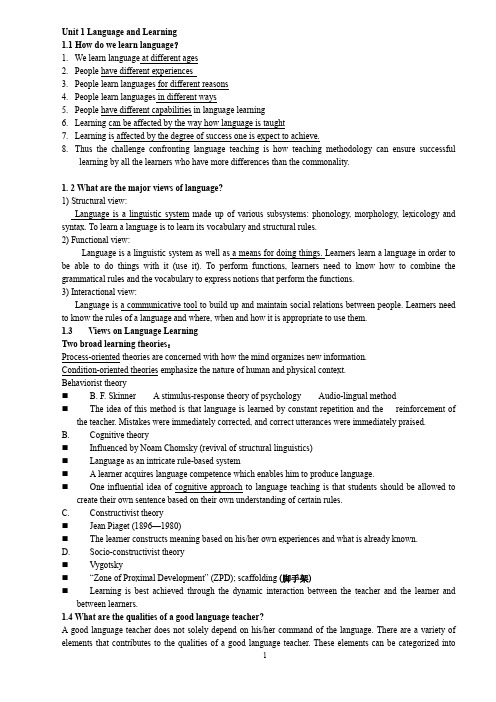
Unit 1 Language and Learning1.1 How do we learn language?1.We learn language at different ages2.People have different experiences3.People learn languages for different reasons4.People learn languages in different ways5.People have different capabilities in language learning6.Learning can be affected by the way how language is taught7.Learning is affected by the degree of success one is expect to achieve.8.Thus the challenge confronting language teaching is how teaching methodology can ensure successfullearning by all the learners who have more differences than the commonality.1. 2 What are the major views of language?1) Structural view:Language is a linguistic system made up of various subsystems: phonology, morphology, lexicology and syntax. To learn a language is to learn its vocabulary and structural rules.2) Functional view:Language is a linguistic system as well as a means for doing things. Learners learn a language in order to be able to do things with it (use it). To perform functions, learners need to know how to combine the grammatical rules and the vocabulary to express notions that perform the functions.3) Interactional view:Language is a communicative tool to build up and maintain social relations between people. Learners need to know the rules of a language and where, when and how it is appropriate to use them.1.3Views on Language LearningTwo broad learning theories:Process-oriented theories are concerned with how the mind organizes new information.Condition-oriented theories emphasize the nature of human and physical context.Behaviorist theory⏹ B. F. Skinner A stimulus-response theory of psychology Audio-lingual method⏹The idea of this method is that language is learned by constant repetition and the reinforcement ofthe teacher. Mistakes were immediately corrected, and correct utterances were immediately praised.B.Cognitive theory⏹Influenced by Noam Chomsky (revival of structural linguistics)⏹Language as an intricate rule-based system⏹ A learner acquires language competence which enables him to produce language.⏹One influential idea of cognitive approach to language teaching is that students should be allowed tocreate their own sentence based on their own understanding of certain rules.C.Constructivist theory⏹Jean Piaget (1896—1980)⏹The learner constructs meaning based on his/her own experiences and what is already known.D.Socio-constructivist theory⏹Vygotsky⏹“Zone of Proximal Development” (ZPD); scaffolding(脚手架)⏹Learning is best achieved through the dynamic interaction between the teacher and the learner andbetween learners.1.4 What are the qualities of a good language teacher?A good language teacher does not solely depend on his/her command of the language. There are a variety of elements that contributes to the qualities of a good language teacher. These elements can be categorized intothree groups: ethic devotion, professional quality and personal styles.1.5 How can one become a good language teacher?☐Wallace’s (1991) ‘reflective model’ (Figure 1.1, p.9)Stage 1: language developmentStage 2: learning, practice, reflectionThe learning stage is the purposeful preparation that a language normally receives before the practice, This preparation can include:1. Learning from others’ experience2. Learning the received knowledge3. Learning from one’s own experiencesThe practice stage (2 senses)Pseudo practice: short period of time assigned to do teaching practice as part of one’s pre-serviceeducation, usually under the supervision of instructorsThe real classroom teaching: what a teacher undertakes after he/she finishes formal education Teachers benefit from practice if they keep on reflecting on what they have been doingGoal: professional competenceUnit 2 Communicative Principles and Task-based language teaching2.1 How is language learned in classrooms different from language used in real life?Language used in real life Language taught in theclassroomTo perform certain communicative functions To focus on forms (structures or patterns)Use all skills, both receptive skills and productive skills To focus on one or two language skills and ignore others.Used in a certain context To isolate language from its context2.2 What is communicative competence?To bridge the gap between classroom language teaching and real-life language use, one solution is to adopt CLT, the goal of which is to develop students’ communicative competence.2.2.1 Definition:Communicative competence include both the knowledge about the language and the knowledge about how to use the language appropriately in communicative situations2.2.2 Five components of communicative competence (Hedge 2000)1.Linguistic competence (语言能力)a)The knowledge of language itself, its form and meaning.2.Pragmatic competence (语用能力)a)The appropriate use of language in social context.3.Discourse competence (语篇能力)One’s ability to create coherent written text or conversation and the ability to understand them4.Strategic competence (策略能力)Strategies one employs when there is communication breakdown due to lack of resources.5.Fluency (流利性)One’s ability to ‘link units of speech together with facility and without strain or inappropriate slowness or undue(过分的,不适当的)hesitation’2.3Implications for teaching and learningTeaching must enable learners to grasp the five components of communicative competence, but not just the linguistic competence.2.4 Principles of CLTThree principles suggest by Richard and Rodgers:1 Communication principle:Involve real communication2 Task principle:Carry out meaningful tasks3 Meaningfulness principle:Meaningful language to the learnerHowatt p roposes a weak and a strong version of CLT:Weak versionLearners first acquire language as a structural system and then learn how to use it in communication.Strong version“Language is acquired through communication” (Howatt, 1984:279)2.5 Major Activity Types of CLTA sequence of activities represented in Littlewood (1981: 86)Pre-communicative activities✓Structural activities✓Quasi-communicative activities类似,准,半Communicative activities (PP22-23)▪Functional communication activities▪Social interaction activities2.6 Six Criteria for evaluating communicative classroom activities(Main features of communicative activities?)municative purposemunicative desire3.Content, not form4.Variety of language5.No teacher intervention6.No materials control2.7 What is Task-based Language Teaching?TBLT is a further development of CLT. It shares the same belief in the use of language in real life, but stresses the importance to combine form-focused teaching with communication-focused teaching.2.7.1Four components of a task1. A purpose2.A context3.A process4.A product2.7.2 Exercises, exercise-tasks and tasksExercise-tasks are halfway between tasks and exercises. This kind of activity consists of contextualized practice of language item.2.8 Differences between PPP and TBLT1 The way students use and experience language in TBLT is radically different from PPP.1.Free of language control2. A genuine need to use language to communicate3. A free exchange of ideas4.Appropriateness & accuracy of language form in general, not production of a single form5. A genuine need for accuracy and fluency2. TBL can provide a context for grammar teaching and form-focused activities. PPP is different in this aspect:1. A task-established context2.Encouraged to think, analyze, not simply to repeat, manipulate and apply3. A more varied exposure to natural languagenguage forms not pre-selected for focus5.Learner-free selection of language6.TBL cycle lead from Fluency to accuracy (+fluency)7.In TBL Integrated skills practiced2.9 How to design tasks?Step 1 Think about students’ needs, interests, and abilities→Step 2 Brainstorm possible tasks→Step 3 Evaluate the list→Step 4 Choose the language items→Step 5 Preparing materials2.10 CLT and TBLT in the Chinese context☐Problems with CLT1. The very first and forceful argument is whether it is culturally appropriate2. The second problem of CLT relates to the design the syllabus for teaching purpose in the classroom.3. The third problem is that whether such an approach is suitable for all age level of learners or all competence level of learners.⏹Constraints of TBLT⏹The first is it may not be effective for presenting new language items⏹The second constraint is Time as teachers have to prepare task-based activities very carefully.⏹The third is the culture of learning⏹The forth is Level of difficultyUnit 33.1 A brief history of foreign language teaching in China1. A phase of restoration (1978-1985)2. A phase of rapid development (1986-1992)3. A phase of reform (1993-2000)4. A phase of innovation from 20003.2 Designing principles for the National English Curriculum1) Aim for educating all students, and emphasize quality-oriented education.2) Promote learner-centeredness, and respect individual differences.3) Develop competence-based objectives, and allow flexibility and adaptability.4) Pay close attention to the learning process, and advocate experiential learning and participation.5) Attach particular importance to formative assessment, and give special attention to the development of competence.6) Optimize learning resources, and maximize opportunities for learning and using the language.3.3 Goals and objectives of English language teachingThe new curriculum is designed to promote students’ overall language ability, which is composed of five interrelated components, namely, language skills, language knowledge, affects, learning strategies and cultural understanding. Each component is further divided into a few sub-categories. Language teaching is no longer aimed only for developing language skills and knowledge, but expanded to developing learners’ positive attitude, motivation, confidence as well as strategies for life-long learning along with cross-cultural knowledge, awareness and capabilities.The overall language ability required in the 2001 National English Curriculum includes the following aspects language knowledge, language skills, learning strategies, affects and cultural understanding.3.4 Design of theNational English Curriculum3.5 The standards for different levels ofcompetence3.6 Challenges facing English language teachers1) English language teachers are expected to change their views about language which is not a system of linguistic knowledge but a means for communication.2) English language teachers are expected to change their traditional role of a knowledge transmitter to a multi-role educator.3) English language teachers are expected to use more task-based activities and put the students at the center of learning.4) English language teachers are expected to use more formative assessment in addition to using tests.5) English language teachers are expected to use modern technology in teaching, creating more effective resources for learning and for using the language.Unit 4. Lesson Planning 备课4.1 Why is Lesson Planning Important A lesson plan is a framework of a lesson in which teachers make advance decisions about what they hope to achieve and how they would like to achieve it.Proper lesson plan is essential for both novice and experienced teachers. Language teachers benefit from lesson planning in a number of ways.1.Makes teachers aware of the aims and language contents of the lesson, so as to plan theactivities and choose the techniques accordingly;2.Helps teachers distinguish the various stages of a lesson and see the relationship between themso that the activities of different difficulty levels can be arranged properly and the lesson can movesmoothly from one stage to another;3.Gives teachers the opportunity to anticipate potential problems so that they can be prepared;4.Gives teachers, esp. novice ones, confidence in class;5.Raises teachers’ awareness of the teaching aids needed;6.Planning is a good practice and a sign of professionalism.Teachers benefit from proper lesson plans in a number of other ways:☐To enable the teacher to improve class timing;☐Lesson plans are also an aid to continuing development(plan←-→practice ←-→reflection)4.2 Principles for Good Lesson Planning1.Aim: the realistic goals for the lesson; what students are able to do by the end of the lesson;2.Variety: different types of activities; a wide selection of materials;3.Flexibility: preparing some extra and alternative tasks and activities4.Learnability: the contents and tasks planned should be within the learning capability of thestudentsDoing things that are beyond or below the students’ coping ability will diminish their motivation(Schumann, 1999)5.Linkage: the stages and the steps within each stage are linked with one another.4.3 What are macro planning and micro planning?Macro planningPlanning over a long period of time which is often done by a group of teachers, it provides a general guidance for language teachersMicro planningPlanning for a specific unit or a lesson, which usually lasts from one to two weeks or forty to fifty minutes respectively. Micro planning is often an individual activity and different teachers may have different ways of writing their own lesson plans.❑Macro planning involves the following:Knowing about the profession Knowing about the institutionKnowing about the learners Knowing about the curriculum/syllabusKnowing about the textbook Knowing about the objectivesA lesson plan usually has the following components:Background information Teaching aims Teaching content and skillsStages and procedures Teaching aids End of lesson summaryOptional activities and Assignment After lesson reflectionUnit 5 Classroom Management5.1 What is classroom management?Classroom management is the way teachers organize what goes on in the classroom. (68)the goal of classroom management is to create an atmosphere conducive to (有助于)interacting in English in meaningful ways (Gebhard, 1996).Efficient classroom management can be achieved when the following six conditions are met:1.The teacher plays appropriate roles.2.The teacher provides clearer instructions.3.Students are grouped in a way suitable for thelearning activities.4.There is discipline as well as harmony in theclass.5.The teacher asks appropriate questions.6.The students’ errors are treated properly 5.2 What roles does the teacher play?1.Controller (what to learn; how to learn)2.Assessor (correcting mistakes; organizingfeedback)anizer (students’ activities)4.Prompter (when Ss don’t know what to do…)5.Participant (in Ss’ activities)6.Resource-providerTeachers’ roles are not static. They change with the development of the society.☐New roles:Teacher as facilitators⏹To create a positive learning environment, use various strategies to motivate learners, guide students inplanning and assessing their learning and develop their learning strategies…Teacher as guide⏹To activate students’ prior knowledge; find individual interests and explore potential capabilities;acknowledge and respect individual differences; give each equal opportunity in learning; evaluate students’ development fairly from an all-round perspective…Teacher as researcher⏹To observe a problem, reflect on the reasons, think about possible solutions, implement the solutions andevaluate the results…Q: How much control is needed?⏹Appropriate degree of control⏹Different activities need different degrees of control.⏹The more communicative an activity is, the less control it needs.Q: What does the teacher do as an assessor?1.Correcting mistakes⏹The correcting should be gentle, not harsh.anizing feedback⏹The feedback should be focused on students’ success or progress so that a success-oriented learningatmosphere can be created.Q: How to organise?⏹Before the activity: what the activity is going to be like, anticipated problems; clear instructions given tostudents (with T’s demonstration)⏹During the activity: overhear what the students are saying, rectify wrong practices; take notes for laterfeedbackQ: When to prompt?⏹When students are not sure how to start an activity, or what to do next, or what to say next…⏹When a student doesn’t seem to be ready for an answer,…⏹When a student finishes with a very short answer,…Q: why to participate in student’s activities?⏹Monitoring + participating changes the role from an authority to a conversationalist, a good chance forstudents to practice English with a superior…Q: What do you think of the jug-and-mug metaphor?Although the jug-and-mug method has been widely criticized, the teacher is still considered a good and convenient resource for the students.”A “jug and mug”theory of education是罗杰斯提出来的,也是他强烈批判的。
英语教学法教程PPT课件

Unit 1 Language & Language Learning
Views on language Views on language learning The qualities of a good language teacher How Can One Become a Good Language Teacher
Most of our day-to-day language use involves functional activities: advising apologizing debating offering
In order to perform functions, learners need to know how to combine the grammatical rules and vocabulary to express notions观念 that perform the functions.
Page 4
Views on language
Structural view Functional view Interactional view
Page 5
① Structural view结构观
The Structural View sees language as a linguistic system made up of various subsystems:
ቤተ መጻሕፍቲ ባይዱ
Unit 1 Language & Language Learning
Views on language Views on language learning The qualities of a good language teacher How Can One Become a Good Language Teacher
《英语教学法教程(第二版)》讲义
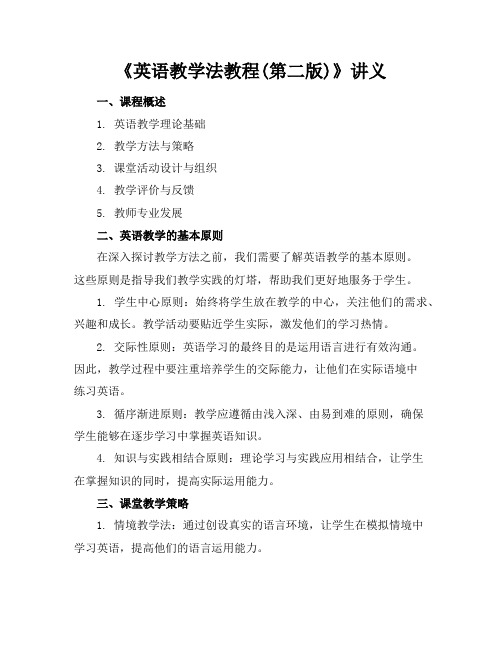
《英语教学法教程(第二版)》讲义一、课程概述1. 英语教学理论基础2. 教学方法与策略3. 课堂活动设计与组织4. 教学评价与反馈5. 教师专业发展二、英语教学的基本原则在深入探讨教学方法之前,我们需要了解英语教学的基本原则。
这些原则是指导我们教学实践的灯塔,帮助我们更好地服务于学生。
1. 学生中心原则:始终将学生放在教学的中心,关注他们的需求、兴趣和成长。
教学活动要贴近学生实际,激发他们的学习热情。
2. 交际性原则:英语学习的最终目的是运用语言进行有效沟通。
因此,教学过程中要注重培养学生的交际能力,让他们在实际语境中练习英语。
3. 循序渐进原则:教学应遵循由浅入深、由易到难的原则,确保学生能够在逐步学习中掌握英语知识。
4. 知识与实践相结合原则:理论学习与实践应用相结合,让学生在掌握知识的同时,提高实际运用能力。
三、课堂教学策略1. 情境教学法:通过创设真实的语言环境,让学生在模拟情境中学习英语,提高他们的语言运用能力。
2. 任务型教学法:以完成任务为目标,引导学生积极参与、合作探究,培养他们的团队协作能力和解决问题的能力。
3. 激励性评价:采用正面、鼓励性的评价方式,关注学生的进步和努力,激发他们的学习积极性。
4. 多元化教学手段:结合现代教育技术,运用多媒体、网络等资源,丰富教学手段,提高教学效果。
四、课堂活动实践2. 互动环节:设计小组讨论、角色扮演等活动,让学生在互动中提高英语听说能力。
3. 语言技能训练:针对听、说、读、写四个方面,设计专项训练活动,帮助学生全面提升英语能力。
通过本讲义的学习,希望您能在英语教学的道路上越走越远,为我国英语教育事业贡献自己的力量。
五、课程资源与材料的选择1. 教材选择:选用符合教学大纲、贴近学生实际、具有时代特色的教材。
同时,注意教材的难易程度,确保学生能够接受。
2. 辅助材料:充分利用网络资源、报刊杂志、影视作品等辅助材料,丰富教学内容,提高学生的学习兴趣。
英语教学法ppt课件

英语教学法及其相关学科
Байду номын сангаас理学对教学法的影响
1. 19世纪,20世纪初,心理学不发达 翻译法,直接法主导 2. 行为主义心理学- 听说法三个实践 A 桑代克(美)饿猫取食 B 巴甫洛夫 狗实验 C 斯金纳(美)白鼠实验 3. 认知心理学冲击 乔姆斯基语言学校理论生成
12
Homework
的方法创立的。 主张先开始听,然后才学习讲,然后
再学习读写。 教学原则: 外语是教学的语音,使用外语教授外
语。 只教授日常使用的词汇和句子。 听、说同时教。 强调正确的发音和句子语法的准确性。
22
2.4 20世纪西方的外语教学
1. 直接法有其不足之处 2. 英国的情景法建立 代表教材:《新概念英语》 3. 20世纪60年代后的西方外语教学
抄写一篇短文章,要求字迹工整
13
第二章 英语教学法简史
学习简史的目的: 1. 帮助我们了解不同历史阶段出
现过的外语教学法; 2. 了解这些教学方法出现的历史
背景,以及一种教学方法为什么 和怎么样被另一种教学方法所取 代。
14
2.1 古代和中世纪西方的外语 教学
在欧洲,拉丁语作为通用语延续 了几个世纪
16
拉丁语由教学语言变成一门课程, 地位下降
16至18世纪外语教学的特点: 一些学者和教育家对当时语言教
学实践不满并不断进行改革。
17
代表人物:
A 阿斯堪(英):重视古文教学, 以翻译作为主要教学手段
B 蒙田(法):提出用“自然法” 学习外语(去外国学习语言文化)
C 柯米尼亚斯(捷克):17世纪 最有影响的教育家,主张用“直 觉法”教学
5
常用的英语教学方法
《英语教学法教程》课件—06
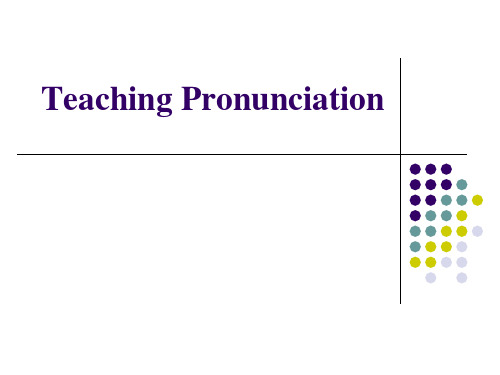
Ⅳ Practising Sounds
Task 4
Imagine that you want to focus on a sound that your students are having difficulty with. Which of the following steps are necessary? In what order would you teach and practice the sound? On the line tick the steps that you think are necessary. In the brackets, write the order numbers.
Helpful Hints for Focusing on a Sound
10.Bad intonation can lead to serious misunderstandings.
Distinction between pronunciation and phonetics
Phonetic rules should be avoided at the beginning stage
Teaching Pronunciation
In the process of communication, pronunciation is of paramount importance, since successful communication cannot take place without correct pronunciation. (Celce-Murcia, Brinton & Goodwin, 1996).
3. Students need to know phonetics in order to learn English. Factors that decide whether
王蔷《英语教学法教程》笔记和课后习题(含考研真题)详解-第4~6章【圣才出品】
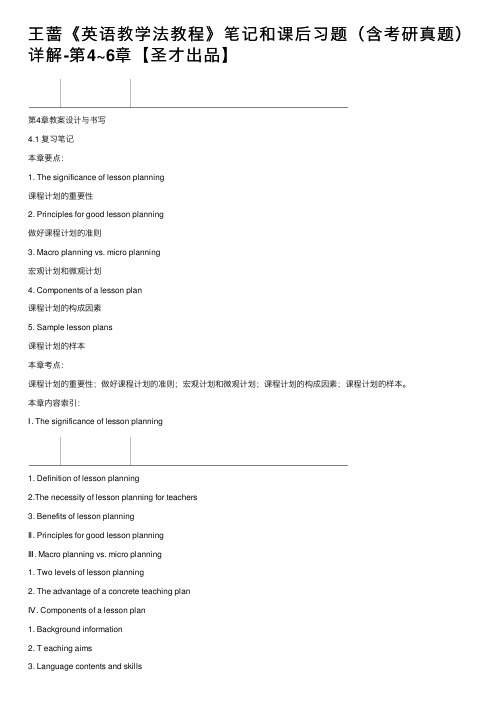
王蔷《英语教学法教程》笔记和课后习题(含考研真题)详解-第4~6章【圣才出品】第4章教案设计与书写4.1 复习笔记本章要点:1. The significance of lesson planning课程计划的重要性2. Principles for good lesson planning做好课程计划的准则3. Macro planning vs. micro planning宏观计划和微观计划4. Components of a lesson plan课程计划的构成因素5. Sample lesson plans课程计划的样本本章考点:课程计划的重要性;做好课程计划的准则;宏观计划和微观计划;课程计划的构成因素;课程计划的样本。
本章内容索引:Ⅰ. The significance of lesson planning1. Definition of lesson planning2.The necessity of lesson planning for teachers3. Benefits of lesson planningⅡ. Principles for good lesson planningⅢ. Macro planning vs. micro planning1. Two levels of lesson planning2. The advantage of a concrete teaching planⅣ. Components of a lesson plan1. Background information2. T eaching aims3. Language contents and skills4. Stages and procedures5. T eaching aids6. End of lesson summary7. Optional activities and assignments8. After lesson reflectionⅤ. Sample lesson plansⅥ. ConclusionⅠ. The significance of lesson planning(课程计划的重要意义)1. Definition of lesson planning课程计划的定义Lesson planning means making decisions in advance about what techniques,activities and materials will be used in the class.课程计划就是提前决定在课堂上使⽤什么技巧、材料、进⾏什么活动。
- 1、下载文档前请自行甄别文档内容的完整性,平台不提供额外的编辑、内容补充、找答案等附加服务。
- 2、"仅部分预览"的文档,不可在线预览部分如存在完整性等问题,可反馈申请退款(可完整预览的文档不适用该条件!)。
- 3、如文档侵犯您的权益,请联系客服反馈,我们会尽快为您处理(人工客服工作时间:9:00-18:30)。
A.Macro Planning
• In a sense, macro planning is not writing lesson plans for specific lesson but rather familiarizing with the context in which language teaching is taking place. Macro planning involves the following:
1) Knowing about the course:
The teacher should get to know which language areas and language skills should be taught or practised in a course, what materials and teaching aids are available, and what methods and techniques can be used.
2) Knowing about the institution:
• The teacher should get to know the institution’s arrangements regarding time, length, frequency of lessons, physical conditions of classrooms, and exam requirements.
5. Aim
Aim means the realistic goals for the lesson. In other words, the teacher needs to have a clear idea of what he\she would like to achieve for the lesson or what outcomes are expected from the lesson.
3.Learnability:
The contents and tasks planned for the lesson should be within the learning capability of the students. Of course, things should not be too easy either. Doing things that are beyond or below the students’coping ability will diminish their motivation.
- to get to know the components of a lesson plan
- to know the principles for good lesson plann Lesson Planning
1.Variety:
Planning a number of different types of activities and where possible introducing students to a wide selection of materials so that learning is always interesting, motivating and never monotonous for the students.
2.Flexibility:
Planning to use a number of different methods and techniques rather than being a slave to one methodology. This will make teaching and learning more effective and more efficient.
Unit 4 Lesson Planning
Aims of the Unit
- to understand why lesson planning is necessary
- learn the difference between macro planning and micro planning
4.Linkage:
The stages and the steps within each stage are planned in such a way that they are somehow linked with one another. Language learning needs recycling and reinforcement.
II.Macro Planning Vs. Micro Planning
Ideally, lesson planning should be done ay two levels: macro planning and micro planning. The former is planning over time, for instance, the planning for a month,a term, or the whole course. The latter is planning for a specific lesson, which usually lasts 40 or 50 minutes. Of course, there is no clear cut difference between these two types of planning. Micro planning should be based on macro planning, and macro planning is apt to be modified as lessons go on.
